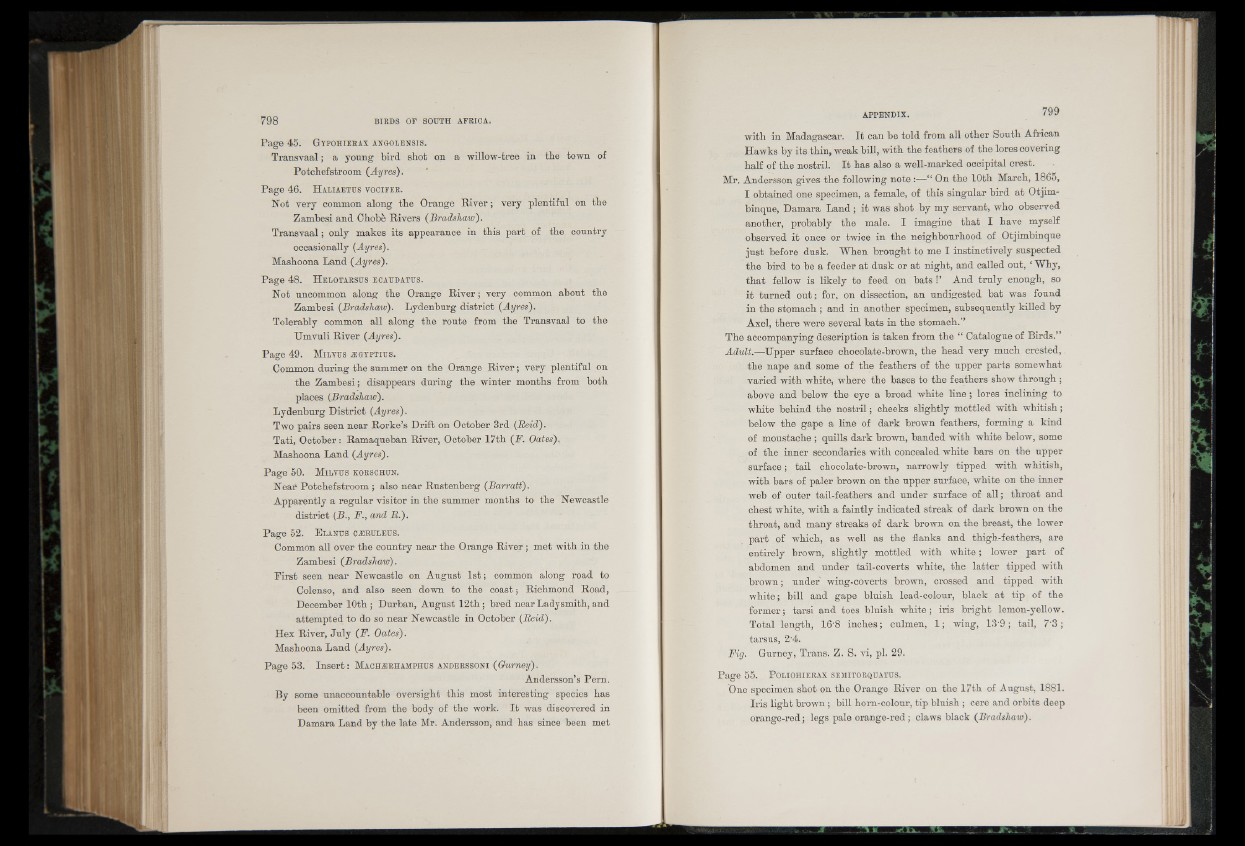
Page 45. G ypohiebax angolensis.
Transvaal; a young bird shot on a willow-tree in the town of
Potchefstroom (Ayres).
Page 4 6 . H aliaetus vociper.
Not very common along the Orange River; very plentiful on the
Zambesi and Chobe Rivers (Bradshaw).
Transvaal; only makes its appearance in this part of the country
occasionally (Ayres).
Mashoona Land (Ayres).
Page 48. H elotarsus ecaudatus.
Not uncommon along the Orange River; very common about the
Zambesi (Bradshaw). Lydenburg district (Ayres).
Tolerably common all along the route from the Transvaal to the
Umvuli River (Ayres).
Page 49. Milvus asgyptius.
Common during the summer on the Orange River; very plentiful on
the Zambesi; disappears during the winter months from both
places (Bradshaw).
Lydenburg District (Ayres).
Two pairs seen near Rorke’s Drift on October 3rd (Reid).
Tati, October: Ramaqueban River, October 17th (F. Oates).
Mashoona Land (Ayres).
Page 50. M ilvus kobschun.
Near Potchefstroom ; also near Rustenberg (Barratt).
Apparently a regular visitor in the summer months to the Newcastle
district (B., F., a/nd R.).
P a g e 52. E l anus cjjeuleus.
Common all over the country near the Orange River ; met with in the
Zambesi (Bradshaw).
First seen near Newcastle on August 1st; common along road to
Colenso, and also seen down to the coast; Richmond Road,
December 10th ; Durban, August 12th; bred near Ladysmith, and
attempted to do so near Newcastle in October (Reid).
Hex River, July (F. Oates).
Mashoona Land (Ayres).
Page 53. Insert: M a c h a jrh am p h u s a n d e r s s o n i (Gurney).
Andersson’s Pern.
By some unaccountable oversight this most interesting species has
been omitted from the body of the work. It was discovered in
Damara Land by the late Mr. Andersson, and has since been met
with in Madagascar. It can be told from all other South African
Hawks by its thin, weak bill, with the feathers of the lores covering
h a lf of the nostril. It has also a well-marked occipital crest.
Mr. Andersson gives the following note :—“ On the 10th March, 1865,
I obtained one specimen, a female, of this singular bird at Otjim-
binque, Damara Land ; it was shot by my servant, who observed
another, probably the male. I imagine that I have myself
observed it once or twice in the neighbourhood of Otjimbinque
just before dusk. When brought to me I instinctively suspected
the bird to be a feeder at dusk or at night, and called out, ‘ Why,
that fellow is likely to feed on bats !’ And truly enough, so
it turned out; for, on dissection, an undigested bat was found
in the stomach ; and in another specimen, subsequently killed by
Axel, there were several bats in the stomach.”
The accompanying description is taken from the “ Catalogue of Birds.”
Adult.—Upper surface chocolate-brown, the head very much crested,
the nape and some of the feathers of the upper parts somewhat
varied with white, where the bases to the feathers show through ;
above and below the eye a broad white line; lores inclining to
white behind the nostril; cheeks slightly mottled with whitish;
below the gape a line of dark brown feathers, forming a kind
of moustache ; quills dark brown, banded with white below, some
of the inner secondaries with concealed white bars on the upper
surface; tail chocolate-brown, narrowly tipped with whitish,
with bars of paler brown on the upper surface, white on the inner
web of outer tail-feathers and under surface of all; throat and
chest white, with a faintly indicated streak of dark brown on the
throat, and many streaks of dark brown on the breast, the lower
part of which, as well as the flanks and thigh-feathers, are
entirely brown, slightly mottled with white; lower part of
abdomen and under tail-coverts white, the latter tipped with
brown; under wing-coverts brown, crossed and tipped with
white; bill and gape bluish lead-colour, black at tip of the
former; tarsi and toes bluish white; iris bright lemon-yellow.
Total length, 16-8 inches; culmen, 1; wing, 13'9; tail, 7'3;
tarsus, 2'4.
Fig. Gurney, Trans. Z. S. vi, pi. 29.
Page 55. P oliohierax semitorquatus.
One specimen shot on the Orange River on the 17th of August, 1881.
Iris light brown ; bill horn-colour, tip bluish ; cere and orbits deep
orange-red; legs pale orange-red; claws black (Bradshaw).